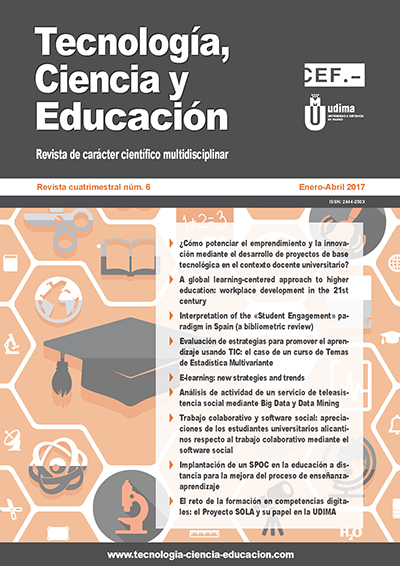E-learning: new strategies and trends
DOI:
https://doi.org/10.51302/tce.2017.116Keywords:
e-learning, massive open on-line courses (MOOC), virtual laboratories, flipped classroom, internet of thingsAbstract
The aim of this paper is to present a personal point of view on the possible future trends in distance learning. The starting point of this study is represented by a review of the main innovations in digital and information technologies. This step is necessary since the evolution of distance learning is strictly correlated to the evolution of the technology that can be exploited to increase learning quality.
The main arguments discussed in this paper are: massive open on-line courses (MOOCs), flipped classrooms and the evolution of the learning objects based on web and on internet technology. Concerning MOOCs, a critical analysis of the status of this type of learning is necessary to understand their possible evolution and/or their substitution. A huge number of case studies demonstrated the validity of the flipped classroom and the possibility to adopt this approach into e-learning is surely interesting. The last part of the paper is instead dedicated to future technologies like: mobile learning, 3D virtual laboratories and internet of things. As discussed, this latest innovations can push the evolution of distance learning offering real student-centered solutions.
Downloads
References
Aguaded-Gómez, I. [2013]: «The MOOC revolution: a new form of education from the technological paradigm?», Comunicar, 41 (17), pp. 7-8.
Barfield, W. [2015]: Fundamentals of wearable computers and augmented reality, United States: CRC Press.
Beetham, H. and Rhona, S. [2013]: Rethinking pedagogy for a digital age: designing for 21st century learning, 2nd ed., England: Routledge.
Cardboard website by Google: https://vr.google.com/cardboard/ [Search: July 2016].
Chaffey, D. [2016]: «Mobile marketing statistics compilation», Smart Insights. Retrieved from: http://www.smartinsights.com/mobile-marketing/mobile-marketing-analytics/mobile-marketing-statistics/ [Search: July 2016].
DailyTekk [2015]: The 7 best 360º cameras and rigs for shooting. Retrieved from: http://dailytekk.com/2015/09/08/the-7-best-360-cameras-and-rigs-for-shooting-insanely-awesome-vr-video/ [Search: July 2016].
Desai, P. R.; Desai, P. N.; Ajmera, K. D. and Mehta, K. [2014]: «A review paper on oculus rift-A virtual reality headset», International Journal of Engineering Trends and Technology, 13 (4), pp. 175-179.
Falaki, H.; Mahajan, R.; Kandula, S.; Lymberopoulos, D.; Govidam, R. and Estrin, D. [2010]: «Diversity in smartphone usage», Proceedings of the 8th International Conference on Mobile System, Applications and Services.
Frankish, K. and Ramsey, W. M. [2014]: The Cambridge handbook of artificial intelligence, England: Cambridge.
Fuchs, C.; Boersma, K.; Albrechtslund, A. and Sandoval, M. [2012]: Internet and surveillance: the challenges of Web 2.0 and social media, England: Routledge.
Garrigos-Simon, F.; Lapiedra Alcamí, R. and Barberá Ribera, T. [2012]: «Social networks and Web 3.0: their impact on the management and marketing of organizations», Journal of Management History, 50 (10), pp. 1.880-1.890.
Gubbi, J.; Buyya, R.; Marusic, S. and Palaniswami, M. [2013]: «Internet of things (IoT): a vision, architectural elements, and future directions», Future Generation Computer Systems 29 (7), pp. 1.645-1.660.
Herreid, C. F. and Schiller, N. A. [2013]: «Case studies and the flipped classroom», Journal of College Science Teaching, 42 (5), pp. 62-66.
Li, J..; Qi, G.; Zhao, D.; Nejdl, W. and Zheng, H.-T. (eds.) [2013]: Semantic web and web science, Springer Proceedings in Complexity.
Martini, M. [2014]: «How modern technologies solve laboratory’s dilemma in distance learning», Digital Universities, 1.
McAuley, A.; Stewart, B.; Siemens, G. And Cormier, D. [2010]: The MOOC model for digital practice. Retrieved from: http://www.elearnspace.org/Articles/MOOC_Final.pdf [Search: July 2016].
Nanney, B. [2004]: Student-centered learning. Retrieved from: http://ollyusofalhaj.ipgkti.edu.my/sumber/resosbestari/PENDEKATAN/scl/7%20SCL-Nanney.pdf [Search: July 2016].
Oculus Rift Website: https://www.oculus.com/en-us/ [Search: July 2016].
Onah, D. F. O.; Sinclair, J. and Boyatt, R. [2014]: «Dropout rates of massive open online courses: behavioural patterns», EDULEARN14 Proceedings, pp. 5.825-5.834.
Paterson, C. [1991]: «Neural network in high energy physics», Proceedings of the conference Computing in High Energy Physics, Annecy (France).
Rennie, F. and Morrison, T. [2013]: E-Learning and social networking handbook, 2nd ed., England: Routledge.
Rosé, C. P.; Ryan, C.; Yang, D.; Wen, M.; Resnick, L.; Goldman, P. and Sherer, J. [2014]: «Social factor that contribute to attrition in MOOCs», Proceedings of the first ACM conference in learning@scale.
TeSLA (webiste of the TeSLA project financed by EU): http://tesla-project.eu [Search: June 2016].
Tucker, B. [2012]: «The flipped classroom», Education Next, 12 (1), pp. 82-83.
Wayback Machine (internet website): archive.org/web/ [Search: July 2016].
Weichert, F.; Bachmann, D.; Rudak, B. and Fisseler, D. [2013]: «Analysis of the accuracy and robustness of the leap motion controller», Sensors, 13 (5), pp. 6.380-6.393.
Wen-Hsiung, W.; Jim Wu, Y.-C.; Chen, C.-Y.; Kao, H.-Y.; Lin, C.-H. and Huang, S.-H. [2012]: «Review of trends from mobile learning studies: a meta-analysis», Computers & Education, 59 (2), pp. 817-827.
Downloads
Published
How to Cite
Issue
Section
License
Copyright (c) 2017 Matteo Martini

This work is licensed under a Creative Commons Attribution-NonCommercial-NoDerivatives 4.0 International License.


























